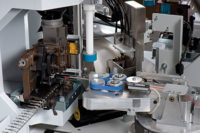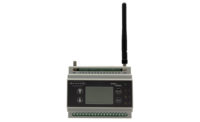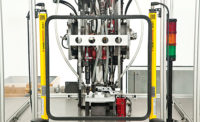Remember the classic illustration about human evolution in elementary school? A silhouette of an ape on all fours gradually transitions to a modern human walking upright.
It’s tempting to think of an assembly line evolving in the same way, beginning with manual production, transitioning to a mix of manual and automated operations, and ending as a fully automatic system requiring little human intervention. In some cases, assembly lines actually do evolve that way. In most cases, though, decisions about how much, if any, automation to employ on a line is a more complex. Where a new assembly line should fit on the spectrum between fully manual on one end and fully automatic on the other depends on myriad factors, such as production volume and variety, product complexity, the number and types of processes needed to assemble the product, the level of in-house expertise, and, of course, cost.
“It can be any of those reasons. Sometimes when demand for a product goes up, the cost of labor to produce higher volumes is not economical,” notes Adam Gustafson, applications engineer at Genesis Automation Inc., a systems integrator in suburban Chicago. “Other times, the processes involved are not ergonomically friendly or require a higher level of control and precision than an operator is capable of performing.”
“Manual assembly systems are slower and generally less accurate that automated assembly systems,” points out Tim Tate, managing director of Edgewater Automation’s facility in St. Joseph, MI. “Companies seeking a competitive edge are moving away from manual assembly processes and towards more automation. Cycle time, production requirements, assembly process accuracy, resource issues, safety applications, and cost are some of the key contributing factors that lead manufactures to implement more automation in their factories.”
Whether manual or automatic, engineers must understand their companies’ goals, the goals for the product to be assembled, and how to justify the costs associated with the investment.
The Spectrum of Automation
Manual assembly systems typically consist of individual workstations for each stage in the assembly process. The product is passed manually from station to station singularly or in batches. In some cases, equipment, such as a nonmotorized roller conveyor, can be used to connect stations. Assemblers manually push the product down the line as its being assembled. This is usually done at lower production volumes.
Although technology, such as lift-assist equipment, poke-yoke devices, and manufacturing execution systems, can be added to manual assembly lines to increase efficiency or improve ergonomics, manual assembly systems typically don’t lend themselves to large increases in production or significant decreases in rejects.
Many companies use manual assembly systems when their products don’t lend themselves to automation. This could be due to an intricate sequence in the assembly system, or a part that has a specialized function or shape. In these cases, manual assembly could be a manufacturer’s only option.
Semiautomatic systems are the broadest part of the assembly system spectrum. These can include the smallest help from an operator, such as manually loading and unloading one or more machines. Or, it can have a great deal of labor, such as having manual checks at every station.
Semiautomatic systems are useful for companies that need to improve their manufacturing process, but aren’t able to completely get away from operator assistance. The products assembled on these systems can benefit from some automation, but some aspects of the assembly are too difficult to fully automate reliably. This can be because the incoming parts can’t be economically fed, or the volumes don’t justify a fully automatic system. Many companies go with this option to realize the significant process improvements while retaining the adaptability of an operator’s input.
“A semiautomatic assembly system could be a synchronous indexing chassis, such as a rotary dial, or an asynchronous platform, such as a pallet-transfer conveyor,” says Gustafson. “Indexing dials work well for semiautomatic systems with a low station count. Pallet-transfer systems work well for semiautomatic systems with a higher number of stations, because pallets can be queued at the manual and automated stations. The buffer of pallets at each station allows the line to run efficiently despite the inconsistent cycle times that can occur at manual stations.”
Fully automatic assembly systems require no human interaction, except for loading bulk supplies of parts and clearing jams. Parts or subassemblies are loaded into feed systems or transferred from another system that will automatically load them into the next step of the assembly process. The automated system then completes the entire assembly, including testing, inspection and unloading.
If a company needs to produce millions of assemblies annually, then a fully automated assembly system is the only way to go. Indeed, many high-volume manufacturers have long experience running fully automated assembly systems, and they are looking to keep long-term costs low by not hiring more workers.
“At Edgewater, our view of a fully automated system is one that requires no operator interaction with the machine,” says Tate. “Parts would typically be automatically loaded onto conveyors, into a feed system, or even transferred directly from another process, such as a mold machine or a machining center. The system would then perform each assembly process automatically, including screwdriving, pressing, testing, vision inspection, unloading the product, and even final pack out. Systems such as this may still require human intervention to clear system faults, bad components or station jams.”
The decision to transition from a semiautomatic assembly system to a fully automated line largely depends on production volume, but other factors play a role, too. Although some companies argue that manual assembly is less expensive than automated assembly, automation could be more economical in the long run.
“You have to look at the cost of labor vs. the cost of full automation,” says Gustafson. “Quality issues and staffing issues are also important. A manufacturer may be unable to hire or keep assemblers. On the other hand, sometimes an assembly process or the handling of a part is just too complicated, and full automation is not sensible.”
If transitioning from a semiautomatic process to a fully automated one, engineers may just need to add to the existing system. In other cases, however, they may have to start from scratch and redesign the entire line.
“This all depends on the part and the process. In many cases fully automating a system will require some disassembly and extensive design implementation,” says Tate.
“Every situation is different and needs to be assessed,” adds Gustafson. “When developing a semiautomatic process, it’s important to assess the likelihood of one day needing to go to a fully automated system, and if need be, lay out a plan that simplifies the transition from semiautomatic to fully automated in the future.”
Even a fully automated line might have a manual workstation or two.
“Sometimes a process is just too awkward or complicated to automate, but it can be done relatively easily by a person,” says Gustafson. “That is good if it makes sense and is not hazardous to the operator.”
For example, Genesis recently designed and built a line with a mix of manual and automated processes. The line that assembled and tested an automotive component.
“Some of the parts being assembled were too large and oddly shaped to feed via traditional feeding methods,” recalls Gustafson. “The only fully automated solution would have been a vision-guided bin-pick robot and custom end-of-arm tooling for each component. Our customer’s budget did not allow for the additional cost of the complex automated part feeding stations. Therefore, manual load stations were implemented. The dexterity of human beings allowed for one operator to load multiple parts, which also reduced the total number of stations on the line.”
ASSEMBLY ONLINE
For more information on manual and automated assembly, visit www.assemblymag.com to read these articles:
Error-Proofing Manual Assembly








